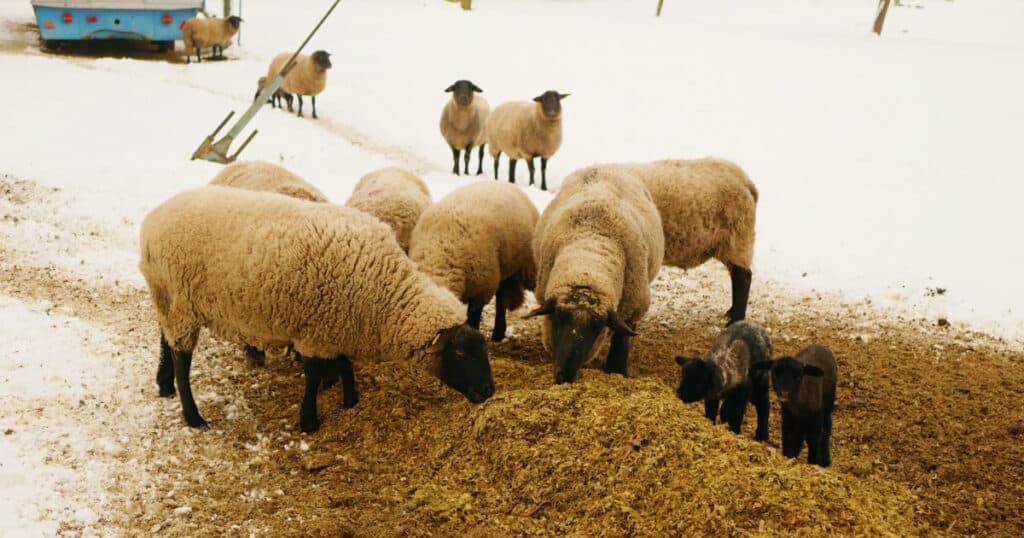Like hay, haylage and silage are forage, and they’re often fed to sheep. They are different from hay, however, in the fact that they are ensiled, which means that they’re fermented. Today, I’ll explore key differences and compare haylage vs silage for sheep, so you can choose the best type of feed for your flock.
The amount of moisture in forage when it’s baled is a crucial factor. It usually determines whether it will be regular hay or ensiled.
If it’s ensiled, it will be either haylage or silage.
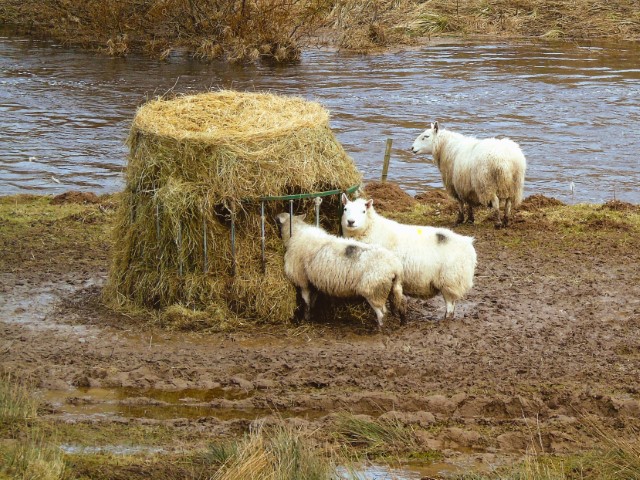
Other factors involved include storage form, the type of forage, palatability, cost, and nutritional content.
Haylage vs Silage Comparison Table
Let’s start with a quick side-by-side comparison of silage vs haylage. It will highlight some key differences. These include moisture content, pH level, and how each is stored.
| Haylage | Silage |
|---|---|
| The moisture content of haylage should be at least 15% and may go up to a maximum of 40%. It is best to stay on the low end of this range. | The moisture content for silage should fall between 35%-40%. |
| Haylage should be maintained with a pH of 4.5 to 5.5. As haylage isn’t as moist as silage, it doesn’t need to be as acidic. | Silage needs to have a pH lower than 4.2. It must be very acidic in order for there to be proper preservation. |
| Haylage is stored in bales with special plastic wrap, to make sure oxygen cannot get in. | Silage is stored in bales with plastic wrap, to ensure that oxygen is not able to get in. |
Now let’s get into a more broad comparison and provide a bit more detail to compare haylage and silage and help you choose the best option for your flock of sheep.
What is Hay?
Fresh grass usually has an 80 percent moisture content when you cut it. This will result in a DM (or dry matter) value of 20 percent or lower.
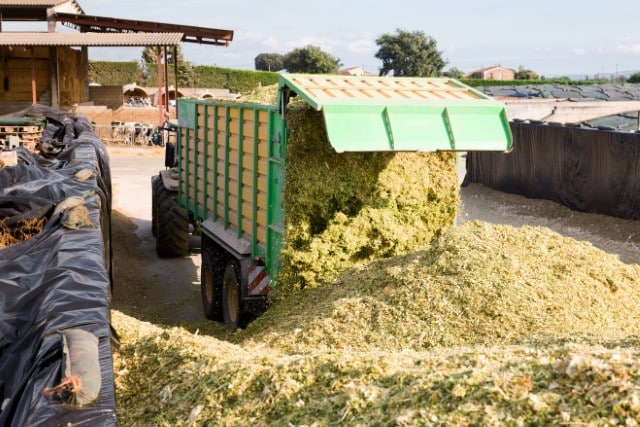
If you intend the grass to be hay, you need to leave it to dry to a low moisture level.
It should be 12 percent or lower. This is 88 percent DM (dry matter).
If a producer bales hay with a moisture level that is more than 12 percent, the bales will be too heavy, will overheat, and will grow mold.
Hay can heat because of metabolic activity. Too much moisture spurs this into action.
In some cases, the hay can get so hot that spontaneous combustion can occur. This can easily end in a barn fire.
RELATED: Haylage vs Hay Comparison (differences explained)
What is Silage?
Like haylage, you make silage by ensiling forage.
This involves packing fresh-cut or wilted grass into an anaerobic environment.
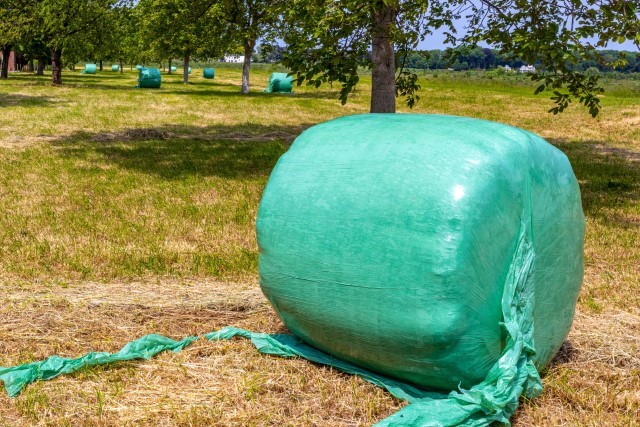
An anaerobic environment is one in which there is a lack of oxygen.
With the ensiling process, there is fermentation of the natural sugars in the grass (these natural sugars are WSC or water soluble carbohydrates), as well as creation of organic acids, such as acetic acid or lactic acid.
The pH drops as acids develop in the packed forage. Eventually, the matter will reach a point at which no further microbial activity is able to occur.
This entire process will usually take around 21 days for completion.
You have to wait for the feed to considered fully ensiled and ready to store. This is at the point when the pH stops dropping.
The bales will be wrapped in plastic. They need to be kept secure in this way, to stop air from getting in.
You can compare every bale to a sort of miniature silo, which has its own individual fermentation process.
Forage Quality Is Key
The quality of the forage that was used to make the silage is key to determining the grade. Another determining factor is how complete the ensiling process was.
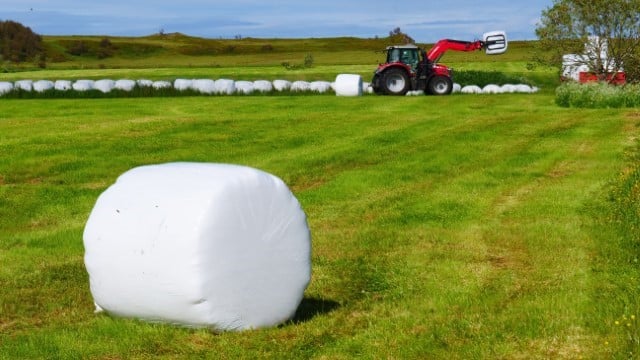
It’s important not to bale forage when it’s too wet. If you do, you won’t be able to get a pH low enough for the fermentation process.
As a result, the forage will be more likely to spoil and there will be lower nutritional quality than you would have with drier bales.
There can be fermentation end products present in the bales.
For example, there could be too much butyric acid, an acid that isn’t as low in pH as you would find with lactic acid.
With butyric acid, you won’t get as good preservation of the forage. There will also be a bad smell.
You should never feed this kind of forage to animals, as it could be harmful and certainly won’t have the proper nutrition.
The forage used to make silage can’t be too dry. If it is, you can’t make the package sufficiently compact to completely keep out oxygen.
Also, there will be too much heat generation.
If you ensile forage without enough moisture content, you can risk overheating and even fire. Barn fires can start this way!
Even if a fire doesn’t happen, there will be a reduction in nutritional quality.
What are Haylage and Silage Made Of?
Silage and haylage are made of the same thing. They are both ensiled forages.
The main difference between haylage and silage is the moisture content of the forage used.
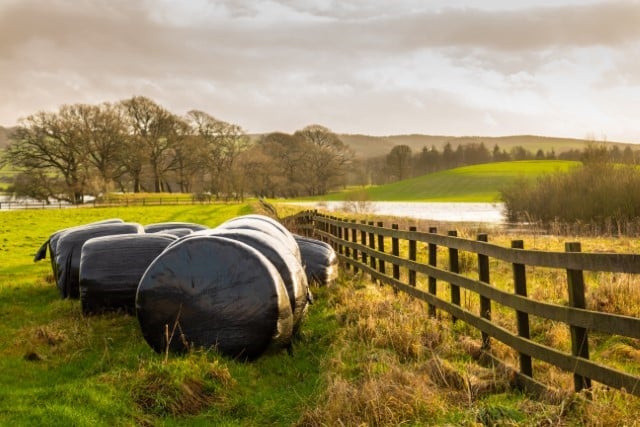
The forage used for haylage usually has a moisture content ranging from 15 percent to an absolute maximum of 40 percent (this means that the DM will be between 60 and 85 percent).
Haylage and silage are both packaged in bales that are wrapped in plastic. The plastic wrapping is necessary to keep out the oxygen.
The forage will be preserved by the sugar fermentation process that happens when oxygen is excluded
When this happens, there is a reduction in pH. Generally speaking, you should look for grass silage in round bales that have a lower than 5 pH.
When it comes to haylage, there won’t be enough moisture for the same kind of fermentation as you get in silage.
With a round haylage bale, there should be a pH of between 4.5 and 5.5.
Haylage doesn’t need quite as low of a pH, as it has less moisture content. This helps to curb microbial growth.
Be aware that both silage and haylage round bales can have “hot spots.”
Hot spots are areas inside of the bales that don’t share the characteristics of the remainder of the bale. This kind of spot may hold improperly fermented or entirely rotten feed.
A hot spot will usually be a result of forage contamination. The source of this contamination could be animal manure, soil, or even dead mice and other animals.
Sometimes small animals will get into the harvesting equipment. Feeding contaminated feed to animals can lead to diseases (such as botulism) and death.
How to Discern Between Hay and Ensiled Forage (such as haylage and silage)
Haylage and silage are wrapped in plastic. Looking out for this is one of the easiest ways of telling the difference between ensiled forage (haylage and silage) and dry hay.
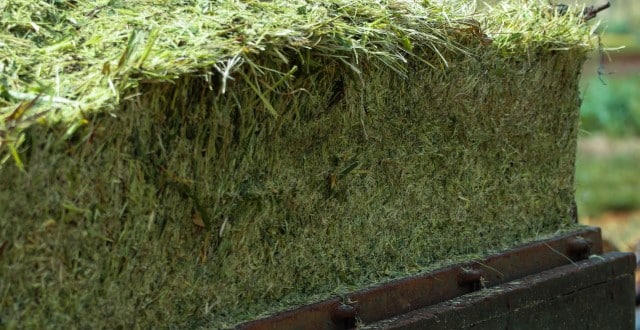
The plastic wrap on haylage and silage is usually green or white, but sometimes it can be black.
Which is Better for Sheep: Haylage or Silage?
In general, it’s better to give your sheep haylage than silage.
Also, haylage is better than regular hay for sheep, as it’s easier to digest. However, you must ensure proper storage and preservation.
Make sure that any haylage or silage you give your sheep doesn’t have any quality problems.
Incorrectly stored haylage and silage can grow dangerous mold. This may result in your sheep contracting listeriosis.
For most small and medium-sized sheep farms, hay is preferred due to the ease of storing and handling it compared to haylage or silage.
Ensiled Forages Nutrition
Ensiled forages (such as haylage and silage) have similar nutritional characteristics to hay.
However, it’s easier for sheep to digest haylage than hay.
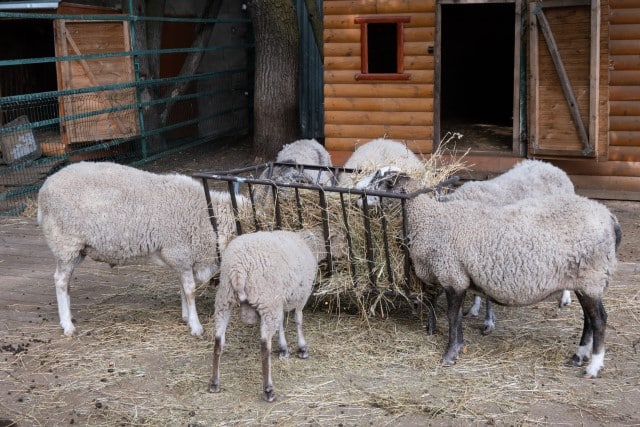
Remember that sheep are ruminants.
When sheep eat regular dry hay, one of their stomachs have to ferment the hay before the rest of the digestive process can happen.
By contrast, haylage and silage are already fermented. As a result, your sheep’s digestive system can process it much more quickly.
Final Thoughts: Haylage vs Silage
Many new sheep farmers get confused between haylage and silage. After all, they’re both protected from oxygen and preserved by fermentation.
But as you’ve seen here, silage usually has a lot more moisture than haylage. That means that it has to be kept at a more acidic pH in order for it to be safely preserved.
However, haylage also requires an acidic pH, so that is something to keep in mind. It’s extremely important that haylage and silage be correctly preserved in order to prevent dangerous mold growth.
To learn more about foods to feed your sheep, check out my Sheep Nutrition Guide. It’ll tell you everything you need to know about what you should feed your flock.
And if you’re raising sheep for wool production, then check this nutrition guide as well – it has information to help you maximize the quantity and quality of fleece each sheep produces on your farm.

